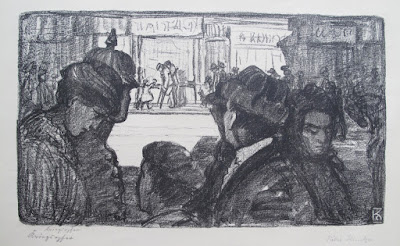This wonderful and iconic print was in eBay ................ for almost two years. I showed it in this Blog 2015 when I first found it. It is a Max Liebermann painting executed in relief print. I loved it then, I love it today. Too expensive ? Not good enough ? Not a good or well known artist ? I often wonder why some prints end in a buyers frenzy and others linger in auction shelves as "shop daughters" (an old Dutch expression for over-date, unloved and unsold articles). My problem: just not enough funds. Never enough funds.
All you see here is what made our (great)-grand-parents lives worthwhile was consumed by "Operation Gomorrah" in the warm summer of 1943: the Anglo-American carpet bombing killing 40.000 people and wiping Hamburg from the face of the earth. Hamburg eventually was rebuild but the Fährhaus location was not. It is to this day an empty plot, a place to jog and, according to recent maps, to walk and relief the dog (it's quite true: "Hunde Auslaufzone").
Max Liebermann (1847-1935) was in Hamburg to paint and he choose another (the other) popular view with roughly the same entourage: a tree covered shaded terrace ("Restaurant Jacob Linden-terasse") not overlooking the Alster but always busy majestic river Elbe.
Recently I sold (I let go) another great and iconic Hamburg print by Ernst Odefey (1882-1964) to travel to America to be part of a serious museum collection. Momentarily "well to do" it was not difficult to chose what was to replace the empty space Odefey left and befitting my collection of works by German woman printmakers. (All suggestions for swapping/trading male/female prints from this day are welcomed).
Margaretha Braumuller-Havemann (1877-1955 ?) had been student of Ernst Neumann (1871-1954) in Munich and as an artist she is not very well known, by only a few examples although she was represented with 11 (!) woodblock prints in Reinhardt Pipers 1904 Munich catalogue of graphic artists. Making her one of the god-mothers of European Modern Printmaking (with Martha Cunz, Norbertine Bresslern, Emma Bormann and of course Emil Orlik)
Margarethe married painter and graphic artist Georg Braumüller (1870-1927) and lived (1921 -30) at Hamburg, Uhlenhorst-straße nr. 3 not very far from the "Ühlenhorst Fährhaus" (Ferryhouse) she depicted. This "Cloth-line" is one of the very few examples I was able to find and locate, and is from un unsigned 1905 edition.
The Ühlenhorst Fährhaus was a popular location to spend a Sundays afternoon, a nice terrace, the Alster waterfront, ferry boats, sailing boats , elegant swans and a great panoramic view over the city of Hamburg with its iconic church- and town hall towers dominating the skyline.
 |
| Hamburg painter Gustav Burkhardt (1890-1970) |
Paul Peaschke (1875-1943) one of my favorite German etchers, showed the "Fährhaus" in an etching with an Armada of boats:
Walter Zeising (1876-1933) choose almost the same point of vantage as Margarethe in this lively and fine etching.
In my efforts to assemble some more biography of Margarethe Havemann I was able to find some interesting facts about her family: she had a sister Hedwig who was an illustrator and a brother Richard who was in his days a famous trainer of wild and exotic animals. He did not recover from a bear attack he'd raised as a cub. More about Margarethe's life in the upcoming book.
In 1913, commissioned and invited by director of Hamburg Kunsthalle Alfred Lichtwark, French impressionist Pierre Bonnard (1867-1947) visited Hamburg and also chose this iconic terrace now lost in history. And since people having memories have long since died, all we have are these works of art and old photographs.
 |
| Hugo Vogel (1855-1934): Fire-works at Ühlenhorster Fährhaus, seen from the terrace. .------------------------------ |
Please send other examples of Margarethe Havemann prints and all biographical facts you might know, for sharing.
-------------------------------
All pictures borrowed freely from the Internet for friendly, educational and non commercial use only.


















































